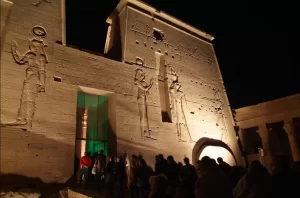2025
The dramatic display of sunlight at dawn, where the inner chambers of the temple gradually illuminate. -Special ceremonies and performances that honor the historical and cultural significance of the event. -Tourist activities surrounding the temples, providing opportunities for cultural exchange and exploration.
On February 22 and October 22 coincide with the birthdays of Ramses II and his coronation, significant events in the history of ancient Egypt. These dates were selected due to the astronomical alignment that enables the sun to enter the temple, illuminating the statues while leaving the statue of Ptah, the god of darkness, in shadow.
The Abu Simbel Sun Festival is captivating due to the rare astronomical alignment that occurs on specific dates of the festival. The sunlight penetrates the inner sanctuary of the Great Temple and gradually illuminates the statues of Ramses II and the major gods, Amun, Ra-Harakhte, and Ptah. This phenomenon is a testament to the advanced knowledge of the ancient Egyptians in the field of astronomy.
The festival is an outdoor event that attracts many visitors every year. To attend this event, it is recommended to book a ticket in advance for the temples of Abu Simbel, as access may be limited due to the popularity of the event. Guided tours are also offered, providing a better understanding of the phenomenon and its historical significance. Be sure to check the event schedule and access conditions.
Abou Simbel houses two magnificent temples carved into the rock—one dedicated to Ramses II and the other to his wife, Queen Nefertari. Both temples were constructed by Ramses II between 1290 and 1224 BC, which can easily be seen as a display of pure egoism by one of the most powerful rulers of ancient Egypt. A seated statue of Ramses II, standing 65 feet tall, greets you at the entrance of

You need to be logged in to send a message.